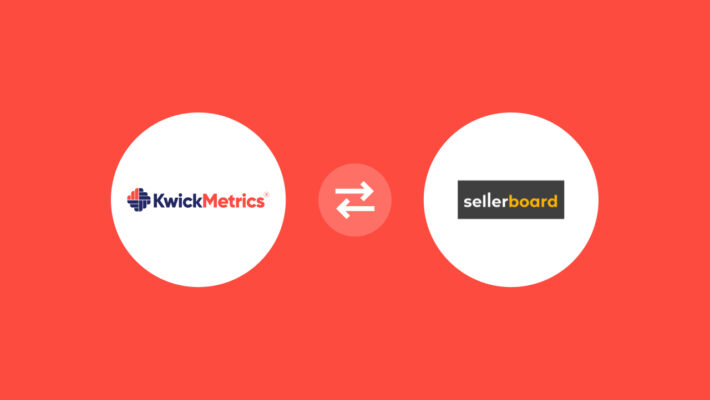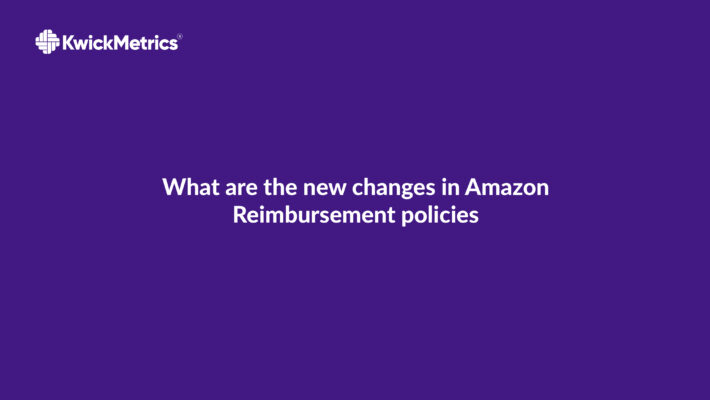2024 Guide to Amazon A9 Algorithm- Tool to Boost Your Visibility

Table of Contents
- What is the Amazon A9 Algorithm?
- Boost Your Sales With KwickMetrics
- Top Factors of Amazon A9 Algorithm
- Explore Our Features!
- How Amazon A9 Algorithm Works
- Try Our KwickMetrics - One Tool with Multiple Solutions!
- Amazon A9 Algorithm Update: Staying Ahead
- How Sellers Used A9 Tools Effectively
- FAQs related to Amazon A9 Algorithm
- Conclusion
In the dynamic landscape of e-commerce, launching a successful product on Amazon depends on understanding the intricacies of SEO on Amazon, which is known as the Amazon A9 Algorithm. Amazon, with its vast product inventory, relies on A9 to connect shoppers with products that align with their needs and preferences. While the inner workings of the A9 Algorithm remain closely guarded by Amazon, sellers can gain a competitive edge by understanding its fundamental principles.
Amazon’s A9 Algorithm is the unseen force that determines the visibility of products in search results. In this article, we will demystify the Amazon A9 Algorithm, delve into the factors it considers, and provide actionable insights on how to elevate your product rankings on Amazon. Let’s embark on this journey to decode Amazon’s A9 Algorithm and propel your products to the top of Amazon’s search results.
What is the Amazon A9 Algorithm?
The A9 algorithm is Amazon’s product search engine. It determines the ranking of products in search results, playing a pivotal role in the Amazon ecosystem. The algorithm enhances the shopping experience by providing relevant search results, thereby making product discovery easier for customers.
Definition and Significance of the A9 Algorithm in the Amazon Ecosystem
The Amazon A9 Algorithm is the proprietary search algorithm developed by Amazon’s A9.com subsidiary. It’s the backbone of Amazon’s product search functionality, determining which products are displayed to a user in response to a particular search query.
The A9 Algorithm is significant in the Amazon ecosystem because it directly influences the visibility of products. It decides which items appear on the first page of search results, which is crucial as these products are more likely to be viewed and purchased by customers.
How A9 Contributes to the Overall Shopping Experience
A seamless and efficient shopping experience lies at the heart of Amazon’s success, and the A9 Algorithm plays a vital role in delivering just that. By continuously refining and optimizing search results, A9 ensures that customers are presented with a curated selection of products that align with their preferences, past behavior, and search queries.
Imagine a virtual marketplace with millions of products competing for attention. Here, A9 acts as the guiding force, directing the right products to the right customers. It considers various factors, including relevance, customer reviews, and historical data, to tailor search results dynamically. This personalized strategy improves not only consumer satisfaction but also a seller’s ability to connect with their target audience.
In essence, the A9 Algorithm is the invisible curator who defines the online buying process by providing products that are not only relevant but also likely to satisfy the customer’s expectations. As we go deeper into the A9 mechanics, we will discover the major aspects that influence product rankings, allowing sellers to optimize their listings for maximum visibility and success on the Amazon marketplace.
Boost Your Sales With KwickMetrics
Explore 14-day free trial! No credit card required, cancel at any time.
Top Factors of Amazon A9 Algorithm
As I delved deeper, I found that the A9 Algorithm was influenced by several factors. Keywords, relevance, and customer behavior were their guiding stars. Product listings, images, and pricing were also crucial. Each factor was a piece of the puzzle, contributing to the overall picture of visibility on Amazon.
Detailed Exploration of Crucial Factors Influencing A9 Rankings
To decode the Amazon A9 Algorithm and unlock the secrets to higher product rankings, sellers must delve into the intricate web of factors that shape A9’s decision-making process. While the algorithm itself is complex and proprietary, certain key elements consistently emerge as pivotal influencers in determining a product’s visibility and success on the platform.
The Amazon A9 Algorithm takes into account a multitude of factors when ranking products. These factors can be broadly categorized into two types: performance factors and relevance factors. Performance factors include historical sales velocity, while relevance factors involve the match between the search query and product listing. each facet plays a role in the delicate dance orchestrated by A9.
Emphasis on the Role of Keywords, Relevance, and Customer Behavior
The heart of Amazon’s A9 Algorithm lies in the crucial trio of keywords, relevance, and customer behavior.
Keywords play a crucial role in the A9 Algorithm, it acts as the bridge between what a customer searches for and what a product offers. Crafting well-optimized product listings with strategic keyword placement is a fundamental aspect of catching the algorithm’s attention. The algorithm matches the search query with keywords in your product title, description, and backend keywords to determine the relevance of your product.
Relevance, in the context of A9, extends beyond keyword matching. It encompasses the overall alignment between a product and a customer’s search intent. A9 seeks to present products that not only contain the right keywords but also resonate with the more closely your product matches the search query.
Customer behavior, another critical factor, reflects how users interact with products. A9 takes clues from past purchasing patterns, click-through rates, and customer reviews to gauge the desirability and relevance of a product. Such as how often customers click on your product when it appears in search results, and how often those clicks lead to a sale. Sellers can leverage this insight by aligning their offerings with customer preferences and optimizing listings accordingly.
Highlighting the Impact of Product Listings, Images, and Pricing
In the visual landscape of online shopping, product listings, images, and pricing emerge as powerful influencers of customer decisions and A9 rankings.
A well-optimized product listing is more likely to rank higher. This includes a detailed product description, accurate category classification, and relevant keywords. An appealing and informative product listing not only attracts customers but also provides A9 with the necessary data to evaluate relevance.
Compelling images, showcasing products from various angles, and highlighting key features, enhance the overall customer experience. A9 recognizes the importance of visual appeal and considers it a factor in determining product rankings. Ensuring high-quality, informative images can improve your click-through rate, influencing your product’s ranking.
Pricing, too, plays a crucial role. A9 considers the competitiveness of pricing to similar products. Sellers must balance offering competitive prices and maintaining profitability to capture A9’s Favor. Competitive pricing can also impact your product’s ranking. If your product is priced significantly higher than similar products, it may rank lower.
Explore Our Features!
How Amazon A9 Algorithm Works
The A9 Algorithm, I learned, was like a well-oiled machine, it is a complex system to rank products. It considers user behavior, historical data, and relevance in shaping search results for individual users. The aim is to provide each user with the most relevant product listings, enhancing their shopping experience and increasing the likelihood of a purchase.
The Mechanics Behind A9’s Product Ranking System
Understanding the inner workings of the Amazon A9 Algorithm is akin to unraveling a complex web of data processing and decision-making. The Amazon A9 Algorithm operates on a two-step process: the first step involves scanning the vast product database to find a set of products relevant to the search query, and the second step involves ranking these products based on various factors. The algorithm uses machine learning techniques to continually refine and improve its search results.
The Role of User Behavior, Historical Data, and Relevance in Search Results
User behavior acts as a guiding light for the A9 Algorithm. By analyzing how customers interact with products from click through rates to purchase patterns Products that are frequently clicked on and purchased tend to rank higher.
The algorithm uses Historical data, including a product’s past performance in terms of sales and customer satisfaction, to predict which products a user is likely to purchase.
Relevance, The relevance of a product to the search query is determined by analyzing the product’s title, description, and backend keywords. The more closely these elements match the search query, the higher the product will rank.
How A9 Tailors Search Results for Individual Users
A notable strength of the A9 Algorithm lies in its ability to personalize search results for individual users. A9 recognizes that each customer is unique, with distinct preferences, purchase histories, and behaviors. To cater to this diversity, the algorithm tailors search results, presenting a curated selection of products that align with the specific interests of each user.
By considering their past behavior, including their search history and purchase history. By doing so, the algorithm can provide personalized product recommendations that are likely to be of interest to the user. This personalization enhances the shopping experience and increases the likelihood of a purchase.
Try Our KwickMetrics - One Tool with Multiple Solutions!
Amazon A9 Algorithm Update: Staying Ahead
In the ever-evolving world of e-commerce, staying informed about algorithm updates is paramount.
Keep informed of any official updates from Amazon about changes to its algorithm. Participate in seller forums and subscribe to e-commerce newsletters to get the latest information.
Regularly review your product’s performance. If you notice a sudden drop in rankings or sales, it could be due to an algorithm update.
If there are changes to the algorithm, adjust your SEO strategy accordingly. This could involve updating your keywords, improving your product listings, or adjusting your pricing.
The A9 Algorithm is a dynamic system that continuously evolves to meet the changing needs and behaviors of online Buyers. Amazon introduces updates to A9 to enhance user experience, address emerging trends, and refine the relevance and accuracy of search results.
How Sellers Used A9 Tools Effectively
Many successful sellers have effectively leveraged the A9 algorithm to boost their product visibility. They do this by optimizing relevant Keywords, and their product listings, using high-quality images, pricing their products competitively, and by using feedback and review automator.
Keyword Optimization: Sellers have used tools to research and identify high-volume, relevant keywords. They’ve incorporated these keywords into their product titles, descriptions, and backend keywords to increase product visibility.
High-Quality Listings: Top sellers have invested time and resources into creating high-quality product listings. They’ve used clear, high-resolution images, written detailed product descriptions, and accurately categorized their products.
Competitive Pricing: Successful sellers have used tools to monitor competitor pricing and ensure their own pricing remains competitive. This has helped them maintain high rankings and attract price-conscious customers.
Customer Reviews and Ratings: Sellers have encouraged satisfied customers to leave positive reviews and ratings. This not only improves their product rankings but also builds trust with potential customers.
By effectively using these strategies, sellers have been able to improve their product rankings, increase visibility, and boost sales on Amazon.
FAQs related to Amazon A9 Algorithm
Q: How does A9 Algorithm affect Amazon product visibility?
A: The A9 Algorithm significantly impacts how products are shown on Amazon by considering factors like keywords, customer behavior, and historical data, tailoring results for users.
Q: What’s the role of keywords in A9 Algorithm optimization?
A: Strategically placing relevant keywords in product titles, descriptions, and backend terms is crucial for A9 optimization, improving the chances of higher search result rankings.
Q: How can sellers adapt to A9 Algorithm changes?
A: To adapt to frequent changes, sellers should stay informed through Amazon Seller Central, engage with the seller community, use analytics tools, and maintain a flexible optimization strategy.
Q: How does customer behavior influence A9 rankings?
A: Customer behavior, including click-through rates, conversion rates, and reviews, is a key factor influencing A9 rankings, indicating the product’s relevance and desirability.
Q: How can sellers create customer-centric listings for A9 Optimization?
A: Creating customer-centric listings involves offering clear, detailed information, high-quality images, and features that directly address customer needs, aligning with the A9 Algorithm’s criteria for relevance and quality.
Conclusion
Amazon A9 Algorithm was more than just a tool; it was a compass, guiding sellers towards greater visibility in the vast ocean of Amazon. As an Amazon seller, understanding and leveraging the A9 Algorithm was not just beneficial it was essential. By focusing on the key factors that influence the A9 rankings and staying updated with the latest changes, sellers can effectively navigate the Amazon marketplace. As the e-commerce landscape continues to evolve, staying ahead in the game requires a dynamic approach to navigate the intricacies of algorithms like A9.


